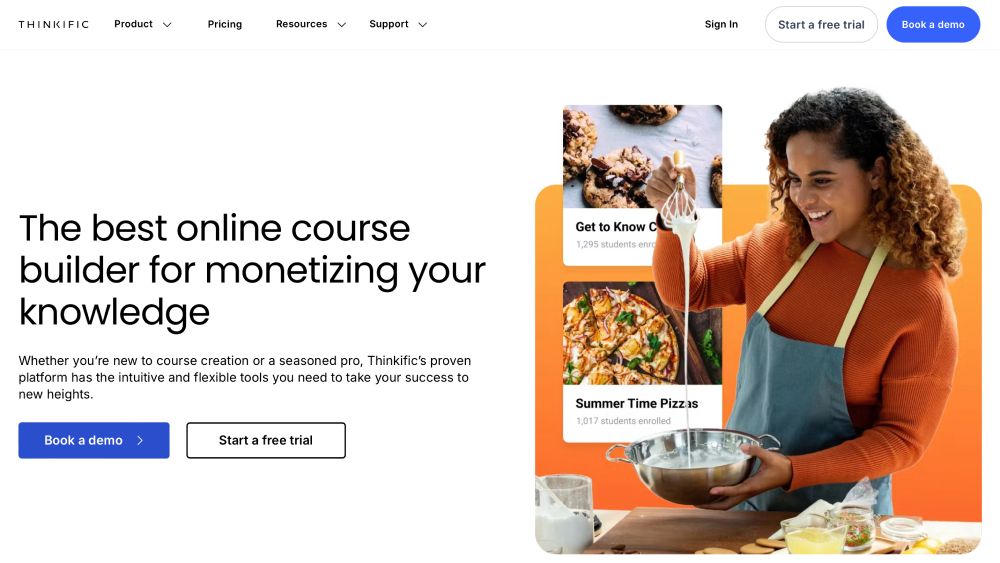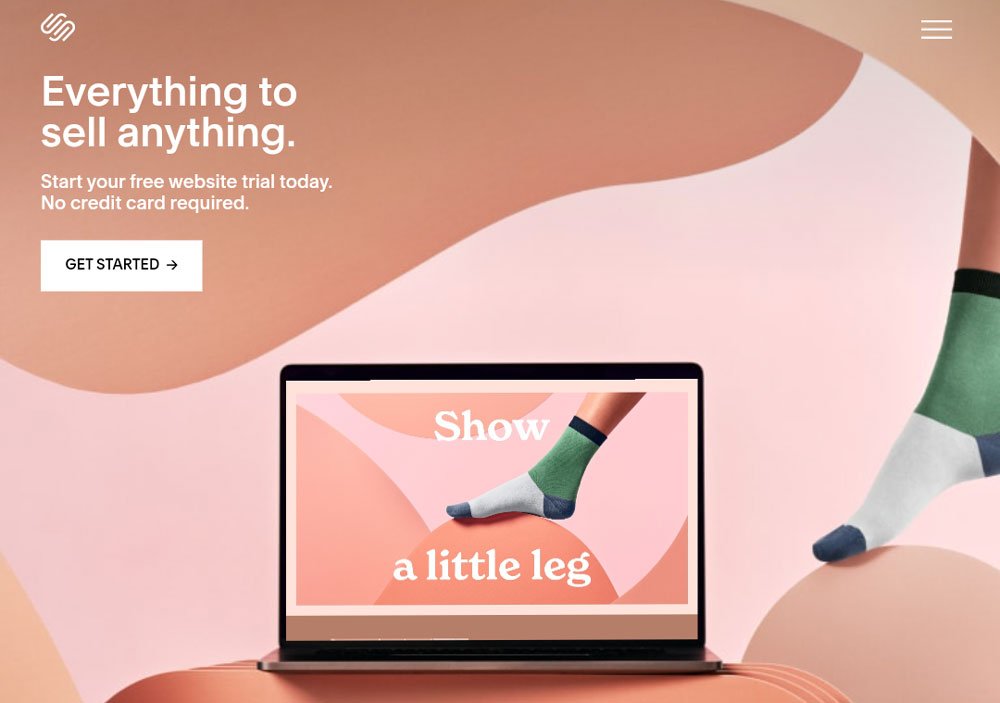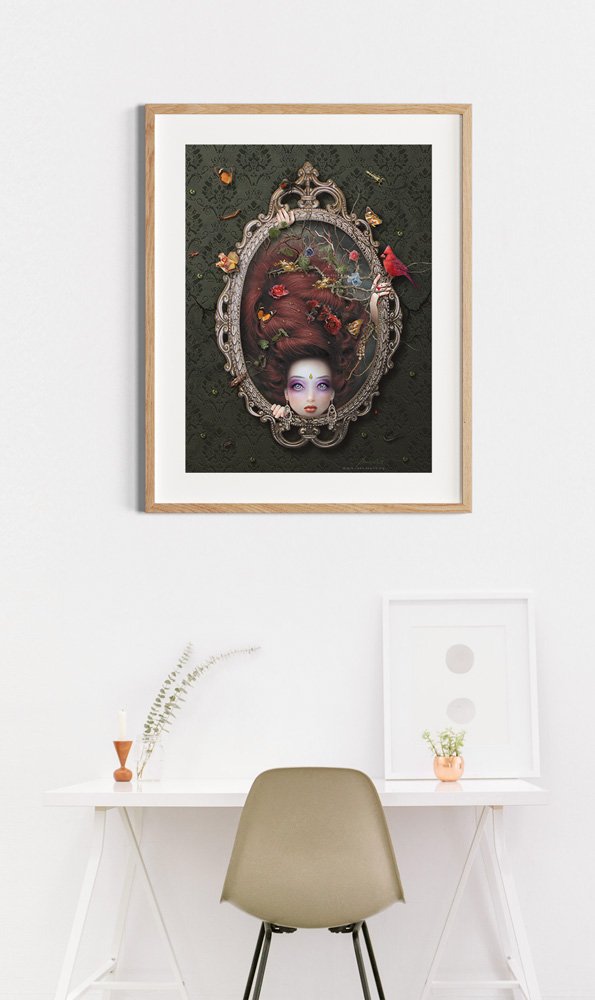If you are a passionate digital artist, you might have been toying with the idea of making your art a full-time business and making a passive income with it. But is there actually a market for digital art? Yes, definitely! Digital art is in demand and making money selling digital art is much more profitable and easy than you might think. In this post, you’ll find the top places for selling for digital art, and everything else you need to know to make money with your creative passion!

When you’re used to seeing oil paintings and other physical artworks being sold in galleries, you might wonder if you can make money selling digital art, too.
The traditional vs. digital debate did its bit to make people think that digital art is less valuable than traditional art, at the time the technology came up.
Nowadays, however, fine art can also be digital, which begs the questions:
Is there a market for digital art? And how much does digital art sell for?
Well, digital art DOES sell – and in many cases, it sells REALLY well.
Digital art may sell in many forms and price ranges, and lots of people and industries around the world are interested in digital products of many types.
The more you get into the ins and outs of selling digital artwork, the more you realize how large there is a market for digital art.
First off, let’s establish what digital art actually is. As I said above, it can come in many different forms – from 2D and 3D work, digital paintings and drawings, photo manipulation and compositing, sculpting, modeling, animation, and so on.
In a word, digital art is everything that is created with the help of computer hardware and a software program.

Is digital art in demand?
Digital art has become more and more popular in recent years. An increasing number of artists are getting interested in creating digital artwork – whether they are new artists or coming from traditional media.
At the same time, the demand for digital art has been rising. Why?
Well, digital art has a number of advantages over traditional works. One advantage is that digital art is much easier to store and deliver than traditional media.
You can send a finished artwork to someone else at the other end of the world in a matter of seconds. The receiver can reproduce it infinitely, without any deviation from the original. That’s why digital art is so popular for commercial projects.
Another advantage is the creation process. Digital art is more forgiving and flexible than traditional art. Just think of how easy it is to undo a mistake in Photoshop. All you need to do is press CMD + Z or go back in the history tool.
Also, you can always change a digital artwork at a later point of time. Thanks to layers, masks, adjustment layers, layer effects, etc., it’s no problem to modify a digital artwork whenever you wish.
Last but not least, you need very little equipment to make digital art. As opposed to traditional art, you don’t have any consumables. The minimum equipment that you need for digital art is a computer, drawing tablet, and software (there are also free options). And even an iPad and an Apple Pencil are enough to create digital art!
Related: TOP 10 Tools Digital Artists Use In Creating Their Artworks
How much does digital art sell for?
The money artists make selling digital art varies hugely, just like it does with traditional art.
The money you can make selling digital art is based on a range of factors: what exactly are you selling? Fine art prints, digital files, print-on-demand products like mugs and t-shirts, commissions, tutorials, …? All of these sell at different prices.
→ The TOP 7 Places To Sell Digital Art Commissions [& How To Start Selling!]
Then, the selling price also depends on the demand for your specific digital art. The more popular you are as a digital artist, the larger your following and fans, the more you can charge for your creations.
Your art style plays a role as well. Surreal art, for example, tends to sell at a higher price than, let’s say, pet portraits.
Every time you sell a digital artwork, you transfer some of the rights to that image over to the buyer. This is done through a license agreement. The more rights you transfer to the buyer, the higher the selling price.
Let me give you an example.
If you only allow the buyer to use the image for personal purposes, the price is lower than when you release your work for commercial use.
If you grant the buyer commercial usage rights, they are allowed to resell your work, for instance, on print-on-demand products.
However, it’s important to always have a digital image license agreement in place. Never give away your digital work without making a contract with the buyer.
You can download free editable license agreement templates (for personal and commercial use) You can download free editable license agreement templates in the Freebie Library.
- Grab your FREE Digital Art Image License Agreement
Is digital art profitable and can you make a living from it?
But how much money you make selling digital art totally depends on how much effort you are willing to put in.
Digital art has been on the rise and will only continue to grow in the future. Over the years, digital art has become more accessible to everyone.
Just look at how the iPad has revolutionized the digital art market. Nowadays, everyone can create art wherever they are, simply with an Apple Pencil and Procreate. It’s super-easy.
This doesn’t mean that traditional art will die out or become less valuable. It’s just two forms of art existing next to each other, with both being equally valuable!
→ 7 Must-Have Skills You Need To Be A Digital Artist [& How To Get Them!]
So, where is there a market for digital art?
Hopefully, you can now see that digital art is profitable and that it’s well worth putting some effort into promoting your art online.
→ How To Promote Your Art When AI Is The End Of Artists (Supposedly)
The truth is that the type of digital art you create will not be such a big factor in whether you make any sales or not. Selling digital art products of all types has the potential to earn you a decent living.
What matters is the effort you put into making your digital art business work. Because your passive income potential directly depends on the amount of work you put in every day.
The great benefit of digital art is that you create something once and then you can sell it over and over again. This wouldn’t be possible with traditional artwork.
In other words, selling digital art products has the potential to earn you a passive income for a very looong time!
With that being said, let’s dive in and see where you actually can sell digital art and make money with it!
- Grab your FREE Art Business Startup Checklist
9 Ways to make money with digital art
Apart from finding the right marketplace for your digital art, many artists are worried that they are ‘not good enough’ making money selling their artwork.
When you look around, it may seem that there are so many other artists who are more talented than you.
A quick word to all those who are still weary of putting their digital art out there: I used to think the same way.
The most important thing is that you learn to build creative confidence—and the rest will follow.
If you do what you love doing, with persistence and dedication, your art will get better and better every day and there will be a market for your digital art!
- Stay in touch!
Our Newsletter is packed with creative tips, free tutorials, art tool reviews, and looaads of inspiration!
Now without further ado, let’s look at the different possibilities to make money selling digital art!
1.
Let’s start with how you can make money selling digital art in the form of prints. Art prints are probably the first thing that comes to mind when you think of the art market.
I believe prints are still the most popular medium to make profit as an artist. In any case, they are a great way to sell digital art!
Selling digital art prints is much easier than prints of traditional works, because all you need to do is save your digital creation in the best file format for printing and then you can send it straight to the printing company.
→ 5 Best Places To Print Digital Art Online
Or, you can upload it to any of the art selling platforms that will take care of everything – from payment processing, manufacturing, to packaging and shipping.
Here are some of the platforms where you can sell digital art prints:
- Etsy is arguably the most popular marketplace for artists to open an ecommerce store. You can sell both physical and digital products (we are going to talk more about selling downloadable items later on in this post). Handmade and custom products are in demand as well. It’s free and super-easy to set up an account on Etsy. Plus, the listing fees and commissions on sales belong to the lowest in the market.
- RedBubble is an Australian-based online marketplace for art with a global customer base. It’s also one of the best go-to places for digital artists to sell prints of their creations. Like most other art selling platforms, RedBubble is free to join. Once you’ve created an account, you can start uploading your art and set your own prices. RedBubble takes over the complete order fulfillment for you, meaning you as the artist don’t need to worry about anything!
- Society6 offers a large selection of fine art prints (from postcard to canvas prints) that you can sell on the platform. It’s a popular place for artists and art lovers. You can create a free account and just pick the products you want to sell. On the flipside, Society6 is not the most profitable place to sell art. Even though you can set your own markup, you will only get around 10% of every sale.
- FineArtAmerica is one of the biggest art selling platforms out there. Originally, it started out as a place to sell traditional fine art. But nowadays, there is a great market for digital art as well. Fine Art America has different pricing and markup schemes depending on the type of product. There’s a base price for each product that covers production costs and shipping.
Another option is to produce and ship your digital art prints yourself.
You can market your prints on Instagram, Facebook, Pinterest, TikTok, etc. and take orders via DM. If you cannot print your art at home, you can use a drop-shipping company.
Making art prints at home is not the cheapest and most convenient way to sell digital art. Using a drop-shipper makes things much more simple and cost-effective!
→ How To Sell Art Prints From Home In 4 Easy Steps
First off, you’ll need to decide what kind of printing paper you want to offer your art prints on. Giclée is the best paper for professional fine art prints. It lasts the longest and only uses the highest quality paper and inks. You can thus sell Giclée prints for more money. Other options include matte, glossy, and metallic printing papers.
Some of the best drop-shipping companies for fine art prints are:
- FinerWorks and Pictorem are both specialize in high-quality Giclée printing. You’ll only need to place the order and they’ll take care of everything for you (printing, packaging, shipping). You can also easily integrate them to your Etsy shop or personal web store on your own artist website or Shopify, etc.
- Printful is a fine art drop-shipper that does not only print at competitive rates, but also allows you to set your own prices. You determine your profit margin because you set the digital art selling price! You can also connect Printful to your online store on Etsy, Squarespace, Shopify, Amazon, …
- Printify is a fine art drop-shipper similar to Printful. You can bypass the use of an art selling platform and have your digital art print shipped directly to the customer. Just like Printful, it’s easy to link Printify to your Etsy shop or other web store, if you wish to do so!
Here’s more on how to make your prints look good for sale:
2.
Apart from selling fine art prints, there is a market for digital art in terms of print-on-demand products.
PoD products are a great way to create a huge variety of products with your digital artwork.
You can create anything from mugs, phone cases, T-shirts, notebooks, stickers, postcards, stationery, pillows, and much more.
To start selling digital art on print-on-demand items, you’ll need to upload your designs to one of the PoD platforms. There, you can choose different mock-ups for your art. Once someone makes a purchase, the PoD provider will send the order to the printing company that prints your design on the selected product and ships it to the customer.
Many of the popular print-on-demand providers also allow you to custom-design your products. Again, you have the option to choose one of the typical art selling platforms to offer your print-on-demand products or sell them via your own website!
Here is a list of the most popular PoD providers:
3.
If you have a talent for graphic design or illustration and know how to use software like Adobe Photoshop and Illustrator, then you might be interested in selling different digital art downloads and printables!
On online platforms, such as Creative Fabrica, Deeezy and Creative Market, you can sell digital downloads like icons, illustrations, mock-ups, clipart, fonts, WordPress themes, templates, and more.
Printables are downloadable files as well. But as opposed to regular downloads, they are particularly intended to be printed out by the buyer. Printables can include images of your artwork. In many cases, artists add inspirational quotes or other text and elements to accompany the art.
The best places to sell digital art printables are Etsy, Sellfy, SendOwl, and Payhip.
The great thing about making money selling digital art as downloads and printables is that you don’t need to worry about shipping physical products.
Once someone purchases your product, they can simply download it from the platform. Everything goes pretty much on its own!
Here’s more for you about selling digital art downloads and printables:
- Grab your FREE Best Selling Printables eGuide
4.
Online courses for digital art are in demand and as an expert in a field – aka you know something that others want to learn – you can teach them!
Sharing your valuable skills with others can be a great way to create a passive income with digital art.
As a digital artist with experience, you can create courses on lots of different topics. For example, you can make a beginner’s guide to your favorite digital art software, like Photoshop or Corel Painter. But you can also deep-dive into more specific topics, such as ‘how to use blending modes in Photoshop’ or ‘how to paint shadows in Corel Painter’.
Creating an online course requires definitely hard work and effort. Recording a course can take several days to weeks. But once you are done with the course, it has the potential to earn you a passive income for years.
Many e-learning platforms will take care of promoting your course. But you can also promote it on your social media sites or your YouTube channel!
These are the best e-learning platforms to upload your digital art course:
- Thinkific is a popular online course platform among creatives that allows you to create and sell your own courses. Once signed up, you can publish an unlimited number of courses, complete with quizzes, assessments, downloadable content, and certifications. Thinkific provides you with all the tools and features you need for your course, including marketing and analytics, student management, and payment processing. You can get started with Thinkific for free here, without any setup fees.
- Payhip is a more budget-friendly alternative to Thinkific that allows you to sell online courses, as well as other digital and physical products. With Payhip’s Forever Free plan, you can teach new artists the ins and outs of digital art, without paying any monthly subscription fee. You’ll need to promote your course on your own. However, you can also set your own prices and thus decide how much money you can make selling your digital art course – even if you have fewer students!
- Udemy is another great online learning platform where you can upload digital art courses. Udemy describe themselves as ‘the leading global marketplace for learning and instruction’. Currently, the platform has more than 45 million users, meaning there’s already an established community potentially interested in your courses. This may take away considerable chunk of promotional work that you’ll have to do when publishing on other platforms.
- Skillshare is a platform similar to Udemy. There’s already a huge audience in place and many students use it to acquire creative skills. When you upload your digital art course to Skillshare, millions of students will have potential access to your classes and you will get paid according to how many minutes a student watches your course. However, as of recently, Skillshare only accepts new teacher in specific categories.
5.
In addition to teaching online courses, you an can offer memberships as a way to monetize your digital art!
How? Well, if you don’t have your own artist website, you can use sites like Payhip, Sellfy, and SendOwl for memberships and subscription-based offers. Payhip even allows you to upload and sell your own courses.
If you already have a good following in place, you can direct your followers over to the membership site. There, you can upload tutorials, tips and advice, perks for supporters, insights into your creative process, and other premium content.
People who are interested in your content can pay from $1 per month to $100 or even more!
The easiest way to create a membership on your own artist website is by using WordPress. There, you can install a plugin like Ultimate Member, Paid Memberships Pro, Simple Membership and open your own membership site!
You can learn here how to make an artist website with WordPress in 5 easy steps.
6.
When it comes to making money as an artist, there is market for digital art commissions, too.
Digital art commissions are works that an artist creates for someone else. It can be any type of creative work, such as a portrait, painting, photo manipulation, concept art, etc. The commission is based on an agreement between the artist and the client.
You can promote your commissions on your social media channels and offer them for sale on sites like Etsy, DeviantArt, Behance, or your own artist website.
I recently wrote two articles about the best places to sell digital art commissions and how much to charge for digital art commissions that you can check out if you wish to learn more about making money with commissions!
7.
Another way to make money with digital art is by licensing images. What exactly does that mean?
Let me explain. An image license allows people to use the virtual file of your creations for certain purposes.
The usage conditions are closely defined in a digital image license agreement. You as the author of the image decide what usage permissions you want to grant the buyer!
For example, you can allow the buyer to use your image for commercial purposes or for personal use only.
The scope of usage determines the price you can license your images for. You can find a complete overview of the image license types here.
(Remember: you can download fully customizable license agreement templates in the Freebie Library.)
Even though it may sound a bit complicated right now, licensing images is one of the easiest ways to sell digital art. It requires the least involvement on your side and has the potential to earn you a passive income for many years.
You only need to upload the image once and then everything pretty much goes its way without you having to look after every sale!
Where can you license your images? Well, your own artist website is the best place, in my opinion. Other sites include Etsy, DeviantArt, Behance, and ArtStation.
8.
I’ve already mentioned it a couple of times throughout this post – your own artist website, most of the time, is the best place for selling digital art!
Your own artist website helps you to establish credibility, build your brand, and sell your work at your own conditions. In fact, there are many good reasons why you should make a website for your art.
One of those reasons is that you can also have a blog on your website. Blogging is a great way to expand your reach, drive traffic from Google and other search engines, and market and sell your artwork.
And there are even more ways to monetize your art blog. For example, you can do affiliate marketing, recommend products and services, display ads, and more.
You are new to blogging? Don’t worry, I got you covered. Here are my best tips on how to become a successful art blogger:
The good news is that building your own artist website isn’t difficult. There are many website building platforms that are easy to use, even for beginners.
Here are the most easy-to-use website builders for artists:
- Squarespace is the perfect website builder for artists because it has so many templates that are geared towards visual creatives. Building your website on Squarespace is easy. All you need to do is choose a template and populate it with your own content. You can also open an online store and run a blog. Try Squarespace for FREE here.
- Simvoly is another favorite to create your own artist website. It’s easy to use and highly versatile in terms of ecommerce and blogging functionality. There are premade templates for art, photography, and fashion design to choose from and you can even start making a website for free. Try Simvoly for FREE here.
- Pixpa is a budget-friendly website builder specifically for artists. It provides you with lots of extra features that artists need, including client galleries, image compression tools, the option to add meta data to images, and much more. The templates are visually stunning and you can also sell art prints, downloadable files, and services. Try Pixpa for FREE here.
- Shopify is a great option for all artists who want to create a dedicated ecommerce store. Shopify has all the powerful features that you need to start selling on a professional level. They also have stunning themes to make your art store look beautiful. Try Shopify for FREE here.
You can learn more about the above website builders and others here:
→ Best Website Hosting For Artists (Paid & Free Website Builders)
Another way to create your own website is WordPress. I have made my artist website with WordPress and I recommend it as the best option. It has a steeper learning curve than the above website builders, but it’s comparably cheaper (you only need WordPress hosting) and it belongs fully to you.
Plus, you probably have the greatest freedom of design and the largest number of plugins to extend your website’s functionality that you can possibly get out there!
Speaking of creating a successful WordPress site, I have an entire guide for you to build an artist website for success. It shows you everything you need to know, from setting up your WordPress site, creating an online store, building a mailing list, to starting an art blog—with a huge chapter on SEO and driving free, organic traffic.
You can find out more about the e-guide here:
9.
Is there a market for digital art we haven’t talked about yet? Yes. Believe or not – YouTube is also a great place to make money as an artist!
Many artists have already joined the platform and generate a passive income from YouTube. They share tips and tutorials, give insights into their creative process, and provide overall valuable information about their art.
YouTube allows you to make money with digital art in multiple ways. First of all, you can earn money directly through YouTube. Then, you can also promote your portfolio, commissions, and other offerings in your videos, and monetize your content with ads.
While you may only have a few viewers when getting started, you can grow your following by uploading videos on a regular basis. YouTube will pay you based on how many views you get on your videos.
Artists with a large number of subscribers are able to make a couple of thousand dollars per month with YouTube!
∗∗∗
Okay, my artsy friend. We’re at the end of this post. I hope this article helped you realize that there is a market for digital art, you’ll just need to seize one of the many opportunities to monetize your work. Do you know another way to make money selling digital art? If so, let me know in the comments. I’d love to hear from you!
Make sure to sign up for my newsletter below so you don’t miss out on new blog posts and other cool stuff. ♥












This was really helpful! Thank you! I’m a photographer and I’m thinking about going digital with some parts of my work so this was great reading and lots of good advice to someone who hasn’t tried the digital market full out! Thanks again!
Hi there, thanks for stopping by! Glad that the article was able to help (: